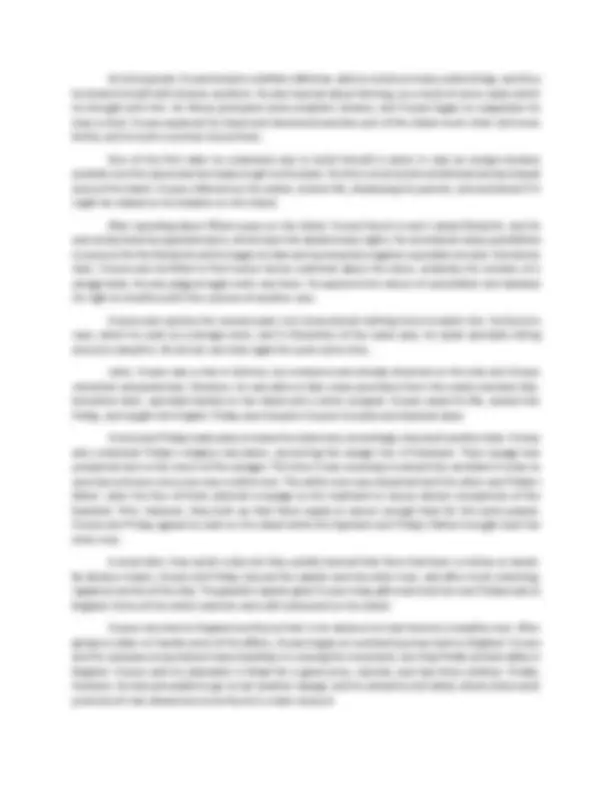



Study with the several resources on Docsity

Earn points by helping other students or get them with a premium plan


Prepare for your exams
Study with the several resources on Docsity

Earn points to download
Earn points by helping other students or get them with a premium plan
Community
Ask the community for help and clear up your study doubts
Discover the best universities in your country according to Docsity users
Free resources
Download our free guides on studying techniques, anxiety management strategies, and thesis advice from Docsity tutors
The novel opens with the vicar and his family. Dr. Charles Primrose lives in his country parish with his wife, Deborah, and their children, among whom are ...
Typology: Study notes
1 / 3

This page cannot be seen from the preview
Don't miss anything!


The Vicar of Wakefield, by Oliver Goldsmith, was originally published in 1766. Goldsmith was an Irish novelist and this novel, written from the point of view of the vicar, was widely popular among Victorians in the late nineteenth century. Goldsmith was friends with Dr. Samuel Johnson, a well-known literary critic and author. Johnson reportedly helped Goldsmith publish the novel in order to pay back rent. Although the novel incorporates multiple genres—everything from poetry to sermons to prose— most critics consider The Vicar of Wakefield to be a fictional memoir told in the first person.
The novel opens with the vicar and his family. Dr. Charles Primrose lives in his country parish with his wife, Deborah, and their children, among whom are George, Olivia, and Sophia. They can afford their comfortable lifestyle because Charles wisely invested inheritance he received from a relative, who passed away before the story begins. Of his wealth, he donates thirty-five pounds to orphans and veterans alike. That money comes from his wages. Charles’ son George is set to marry Arabella Wilmot the next day. Arabella comes from a wealthy family, so the match is considered beneficial to both families until the vicar’s investor goes bankrupt and loses all of the vicar’s money before leaving town in a rush.
As a result, Arabella’s father calls off the wedding and George is sent to town. With his Oxford education, the Primrose family hopes he can make his own way there. The others all move to another parish, humbler in situation than where they lived at the start of the book. It is on land owned by Squire Thornhill. On their way there, they learn about Thornhill’s womanizing reputation. They hear, too, about his uncle’s reputation, which is one of generosity and worth. His uncle is named Sir William Thornhill.
Meanwhile, Sophia nearly drowns but is rescued by a man named Mr. Burchell. The family met him at an inn on their way to their new parish. However, Deborah, who is ambitious for her children and wants them to make advantageous matches, discourages any feelings of attachment Sophia might have for Mr. Burchell. Life settles into happiness and regularity. Both Mr. Burchell and Squire Thornhill visit the family frequently.
Olivia is swayed by Squire Thornhill’s charm and good looks, but she’s not the only one. Both Deborah and Sophia become convinced that their ambitions will be answered should he marry one of them. After Olivia reportedly flees the parish, Charles initially believes Mr. Burchell to be the driving force behind her disappearance. However, when he finds Olivia, he learns that it was Squire Thornhill who persuaded her to leave. He had convinced her they would marry, though he intended only to undergo a mockwedding, and planned to leave her afterwards, which Charles learns is Squire Thornhill’s modus operandi.
Olivia returns home with Charles, only to find that their house is on fire. The family lives, but they lose all of their possessions and money. Squire Thornhill continues to demand that Charles pay rent, despite the fact that the house is destroyed. Since Charles cannot pay, Squire Thornhill has him arrested and brought to debtor’s prison. George, hearing of Squire Thornhill’s behavior, challenges him, but is arrested as well. Sophia is abducted and Olivia reported dead. All seems lost for the vicar, at least until Mr. Burchell returns.
After rescuing Sophia, Mr. Burchell determines that Olivia is alive. The vicar learns that Burchell’s true identity is none other than Sir William Thornhill, the uncle of whom the Primrose family had heard such favorable reports. At the end of the story, there is a double wedding during which George and Arabella are finally able to marry, and Sir William Thornhill marries Sophia. As it turns out, the mockwedding that Squire Thornhill had planned with Olivia wasn’t fake at all, and they are actually married. In a final benevolent twist, the bankrupt investor who lost the vicar’s money at the beginning of the story is rediscovered, and Charles’ wealth is restored.
While this work can be viewed as a satire on sentimental fiction, the main theme of the story is faith. Dr. Charles Primrose, the vicar, can be viewed as Job from the Bible, who suffers and suffers but never loses faith, and whose continued devotion is ultimately rewarded by God. Wakefield is an important site for Christian literature. The Wakefield Master, known for writing the Wakefield Mystery Plays, was a celebrated contributor of mystery plays that conveyed the mysteries of the Christian faith in a way that was accessible to the people. The Wakefield Master’s works are well-known and studied in literary criticism to this day. By placing the vicar in Wakefield, Goldsmith draws a bridge between The Vicar of Wakefield and those mystery plays.
The Vicar of Wakefield is mentioned in a number of other literary classics, including but not limited to Middlemarch by George Eliot, Emma by Jane Austen, A Tale of Two Cities by Charles Dickens, Frankenstein by Mary Shelley, and Little Women by Louisa May Alcott. There were three silent film adaptations of The Vicar of Wakefield in 1910, 1913, and 1916.
Robinson Crusoe, as a young and impulsive wanderer, defied his parents and went to sea. He was involved in a series of violent storms at sea and was warned by the captain that he should not be a seafaring man. Ashamed to go home, Crusoe boarded another ship and returned from a successful trip to Africa. Taking off again, Crusoe met with bad luck and was taken prisoner in Sallee. His captors sent Crusoe out to fish, and he used this to his advantage and escaped, along with a slave.
He was rescued by a Portuguese ship and started a new adventure. He landed in Brazil, and, after some time, he became the owner of a sugar plantation. Hoping to increase his wealth by buying slaves, he aligned himself with other planters and undertook a trip to Africa in order to bring back a shipload of slaves. After surviving a storm, Crusoe and the others were shipwrecked. He was thrown upon shore only to discover that he was the sole survivor of the wreck.
Crusoe made immediate plans for food, and then shelter, to protect himself from wild animals. He brought as many things as possible from the wrecked ship, things that would be useful later to him. In addition, he began to develop talents that he had never used in order to provide himself with necessities. Cut off from the company of men, he began to communicate with God, thus beginning the first part of his religious conversion. To keep his sanity and to entertain himself, he began a journal. In the journal, he recorded every task that he performed each day since he had been marooned.